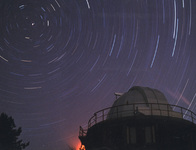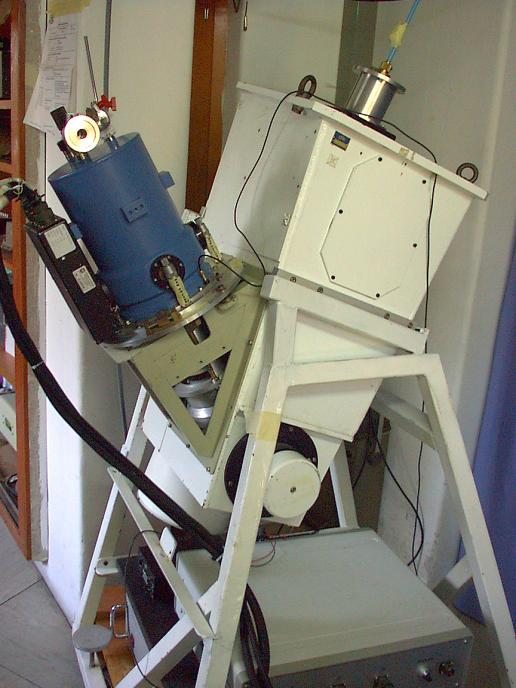| FRESCO |
 |
 |
 |
|
(Fiber-optic Reosc Echelle Spectrograph of Catania Observatory)
The echelle spectrograph delivered by REOSC (France), was designed to work at the F/15 cassegrain focus of the 91-cm telescope. The spectrograph is designed to work at high resolution, in cross-dispersion mode and at low resolution, in single dispersion mode. Since 1993 the spectrograph is fed by a fiber link and placed in a gravity independent position at the first floor of the 91-cm dome. The room temperature is not accurately stabilized, but night-to-day and seasonal temperature excursions are very limited (< 10 C). The stable position and the intrinsic insensitivity to temperature make the spectrograph very suitable for accurate radial velocity measurements (DV< 0.3 km/s rms). The spectral coverage ranges from 3800 A to 8000 A.
Optical configuration: i) Collimator: coated mirror of 1275 mm focal length, F/15 (off-axis parabola of 90x110 mm illuminated area)
Gratings: - echelle grating: reflection grating of 128x254 mm, with 79 l/mm blazed at 63.433 deg.
Dispersion modes:
Detector A CCD camera based on a thinned back-illuminated SITe chip (SI033B) of 1024x1024 pixels (24x24 micron) is used to acquire the spectra, both at high and low resolution. The image acquisition system is a copy of the TNG system.) The camera was built at the CCD lab of Catania Observatory.
Camera main parameters: Maximum QE: 85% at 6500 A Read-out noise: 10 e - rms Conversion factor: 2.5 e-/ADU
Fiber link and calibration lamps The spectrograph is connected to the telescope by a single fiber. A choice of 100 and 200 micron core fibers is available. All fiber are of UV-VIS type with very high transmission in the visible (T=99.98%/m ) and fairly high in the near UV (98%/m). A microlens system optimizes the telescope stellar image size on the fiber input, while an afocal combination of two achromats is used to convert the ~F/5 output beam of the fiber into F/15 to match the spectrograph focal ratio. Taking into account all the light losses produced by the fiber transmission, the optical elements and the slit aperture, an average efficiency of 60 % is estimated.
The calibration lamps (an alogen flat field lamp at about 2600 oC and a Thorium-Argon hollow cathod lamp) are located in the iterface box holding the fiber input terminal at the telescope focus. A movable 45o mirror alternatively send the light of both lamps into the fiber input. In this way the lamps and star light follow the same optical path to the spectrograph input, minimizing the fiber transmission effects and wavelength off-sets. The interface holder include TV guiding system composed of a relays lens and an intensified camera which receive 10% of the star light from a 45o semitransparent beam-splitter.
Spectrograph performances - radial velocity measurements; - DV < 0.3 km/s rms - S/N at H-alpha 100 with Texp = 10 m for V=6 - limiting magnitude V=11 with S/N =30 and Texp = 1 h
Snapshots of typical high-resolution spectra
This e-mail address is being protected from spambots. You need JavaScript enabled to view it |
| Last Updated on Friday, 07 January 2011 12:54 |
 91 cm Telescope
91 cm Telescope



